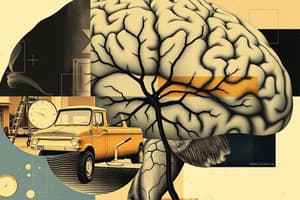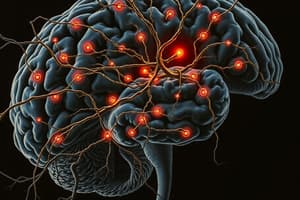Podcast
Questions and Answers
Which of the following brain structures is directly involved in the regulation of our fundamental biological needs, such as hunger and thirst?
Which of the following brain structures is directly involved in the regulation of our fundamental biological needs, such as hunger and thirst?
- Amygdala
- Hippocampus
- Hypothalamus (correct)
- Cerebrum
What is the primary function of the cerebellum?
What is the primary function of the cerebellum?
- Processing sensory information from the environment
- Generating voluntary movements
- Regulating emotions and responses to fear
- Coordinating movement, balance, and some cognitive functions (correct)
What is the term for the brain's remarkable ability to change and adapt in response to experiences, learning, and injury?
What is the term for the brain's remarkable ability to change and adapt in response to experiences, learning, and injury?
- Prefrontal Cortex
- Cerebral Cortex
- Cognitive Function
- Neuroplasticity (correct)
Which brain region is considered the "personality" part, responsible for reasoning, planning, and impulse control?
Which brain region is considered the "personality" part, responsible for reasoning, planning, and impulse control?
What is the outer layer of the cerebrum, responsible for complex tasks like reasoning, language, and motor control?
What is the outer layer of the cerebrum, responsible for complex tasks like reasoning, language, and motor control?
Which brain structure is implicated in the processing and regulation of emotions, particularly fear and aggression?
Which brain structure is implicated in the processing and regulation of emotions, particularly fear and aggression?
What is the name for the four main divisions of the cerebrum, each associated with specific functions?
What is the name for the four main divisions of the cerebrum, each associated with specific functions?
Which of these is NOT a cognitive function controlled by the brain?
Which of these is NOT a cognitive function controlled by the brain?
Flashcards
Central Nervous System (CNS)
Central Nervous System (CNS)
The part of the nervous system that includes the brain and spinal cord, responsible for processing and coordinating information.
Neurons
Neurons
Specialized cells in the nervous system that transmit electrical and chemical signals for communication in the body.
Cerebrum
Cerebrum
The largest part of the brain responsible for higher cognitive functions like thinking and memory.
Cerebral Cortex
Cerebral Cortex
Signup and view all the flashcards
Prefrontal Cortex
Prefrontal Cortex
Signup and view all the flashcards
Cerebellum
Cerebellum
Signup and view all the flashcards
Hippocampus
Hippocampus
Signup and view all the flashcards
Neuroplasticity
Neuroplasticity
Signup and view all the flashcards
Study Notes
Central Nervous System (CNS)
- Comprises the brain and spinal cord.
- Processes and coordinates information throughout the body.
Neurons
- Specialized cells transmitting electrical and chemical signals.
- Enable communication between body parts.
Cerebrum
- Largest brain part.
- Responsible for higher cognitive functions (thinking, memory, voluntary movement).
Cerebral Cortex
- Outer layer of the cerebrum.
- Processes sensory information, reasoning, and voluntary movements.
Prefrontal Cortex
- Associated with personality, reason, thoughts, actions, and emotions.
- Plays a role in executive functions like decision-making and impulse control.
Brainstem
- Connects cerebrum and spinal cord.
- Controls basic life functions (breathing, heart rate, blood pressure).
Cerebellum
- Located below cerebrum, at the back of the head.
- Coordinates voluntary muscle movements, balance, and some cognitive functions.
Lobes
- Four divisions of the cerebrum (frontal, parietal, temporal, occipital).
- Each lobe has specific functions (motor, sensory, language, vision).
Hypothalamus
- Region below the thalamus.
- Regulates body temperature, hunger, thirst, and other physiological processes.
Amygdala
- Small, almond-shaped structure.
- Processes and regulates emotions, particularly fear and aggression.
Hippocampus
- Curved structure in the temporal lobe.
- Crucial for memory formation, retrieval, and spatial navigation.
Neuroplasticity
- Brain's ability to change and adapt to experiences, learning, and injury.
- Allows for new neural connections and rewiring.
Cognitive Function
- Mental processes (thinking, memory, attention, problem-solving).
- Controlled by the brain.
Behavior
- Observable actions, responses, and conduct.
- Influenced by the brain, emotions, and external factors.
Studying That Suits You
Use AI to generate personalized quizzes and flashcards to suit your learning preferences.




